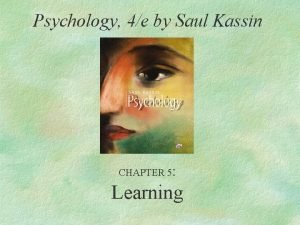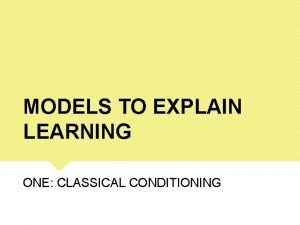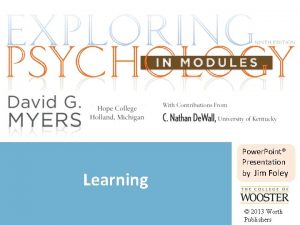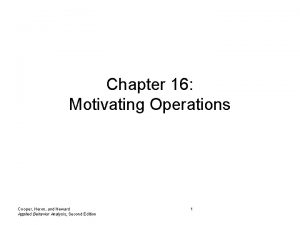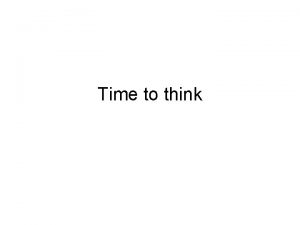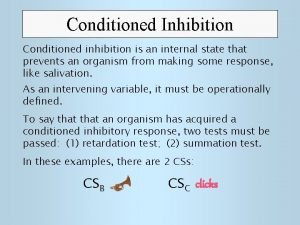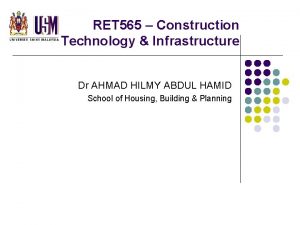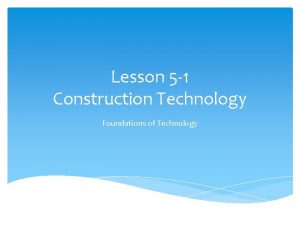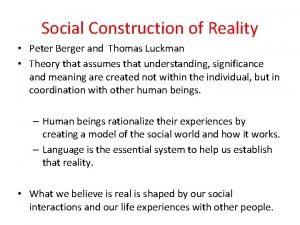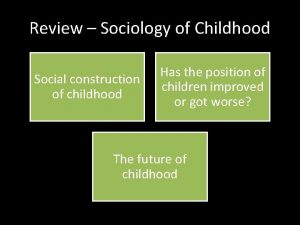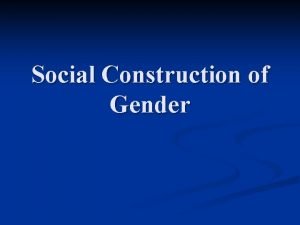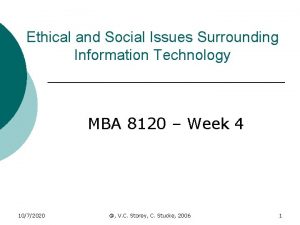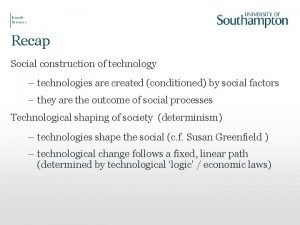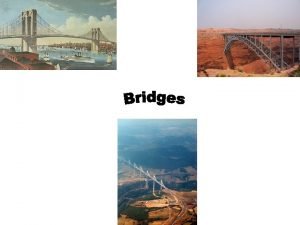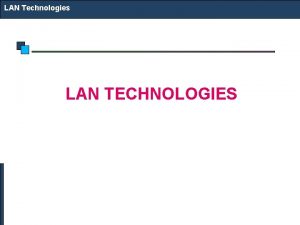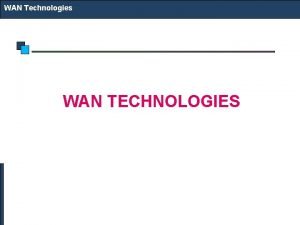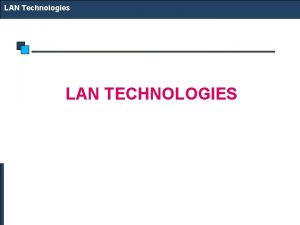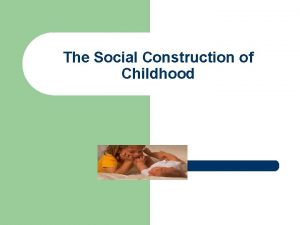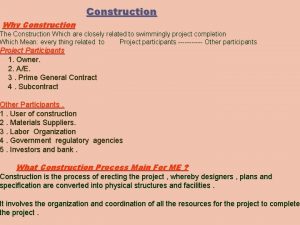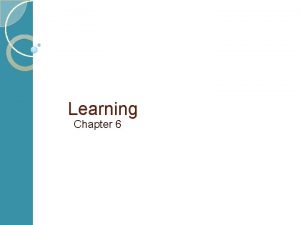Social construction of technology technologies are created conditioned



























- Slides: 27

Social construction of technology – technologies are created (conditioned) by social factors – they are the outcome of social processes Technological shaping of society – technologies shape social contexts (cf Susan Greenfield ) – technological change follows a fixed, linear path (determined by technological ‘logic’ / economic laws)

? Modernity Post modernity

Pre-modern • Traditional (agrarian/feudal) • Pre-ordained position • Natural (Divine) law • Natural and ‘man-made’ are the same

Modernity • Capitalist (industrial) • Social order (division of labour) is socially created • Nature/society and nature/science are distinct

Technology … Modernity • Technology made modernity possible (Brey) • Modernity and technology = “tangled” (Misa) Misa T, Brey P, Feenberg A. (eds) Modernity and Technology. MIT Press, 2003 • ‘Information society’ is the product of ‘information technology’

Modernity as cultural shift • Art (reject realism) • Architecture (e. g. Le Corbusier) • Production (e. g. Model T Ford)

Renaissance • C 12 th (mediaeval) • C 15/16 th ‘bridge to modernity’ – Humanism (resurgence of the classics, rhetoric, dissemination, political citizenry) – Art (da Vinci, Michelangelo… perspective & light) – Science (reason and evidence, questioning) – Religion (reformation, challenge to Catholicism) – Technology (windmills, spinning wheels, Arabic no. s)

Enlightenment • C 18 th – philosophy, mathematics (Spinoza, Locke, Newton…) • ‘emancipation from ignorance’ (Kant) • Emergency of civil society/public sphere – Democracy (equality, freedom) – Literacy (debate, critique and discussion) – Question religious/monarchical authority • Reason / science & rationality • ‘progress’ / Industrial revolution

Industrial revolution • Mechanisation – Technologies (e. g. textile, mining, steam engine) • Population growth • Urbanisation • Productivity increases -> Trade expansion

Scientific attitude – Direct observation (empiricism) – Demarcation (break with natural law, testing) – Reject idealism (Plato) and essentialism (Aristotle) – Causality (laws) – Idea of progress

Impact… • Economic complexity/inter-related institutions and phenomena • Rise of democracy and nation state Ø We can transform the world (and science is central to this)

Theorising modernity Modernity as a way of organising social life • Weber (rationalisation) • Marx (changed economic structure – new productive power relations - capitalism) • Giddens (dynamism and globalisation) • Beck (reflexive – dealing with risk) • Castells (networked society)

Weber • Rationalisation is the key to modernity – Technological – standardization of knowledge and production – Rational calculation (e. g. of profit) – Administrative order (bureaucracy, division of labour ) – Disenchantment (elimination of magic/supernatural ) Modernity as liberating (progress, reason, freedom) but also the “iron cage” of modern bureaucratic organizational forms

Marx • Shared Weber’s view of rationalisation and technological progress “The hand-mill gives you society with the feudal lord; the steam-mill society with the industrial capitalist. ” (1847) • but also saw the ‘dark side’ to modernity - technological and market alienation (in labour process and from the result/product of labour) • the culture of the working class produced by technology

Giddens • Modernity as resting on 4 institutions: industrialism, capitalism, surveillance, military. • Key features – Separation of time and space, – Disembedding of social life (e. g. timetables, money) – Reflexive appropriation of knowledge

Beck • simple modernization = the transformation of agrarian society into industrial society. • (late) modernity = reflexive modernization modern society confronts itself with the negative consequences of simple modernization; less about distribution of goods – more about distribution of risks.

Castells • information age = economic organization via the network (subjects and organizations) continually modified and adapting to (market) environments • opposition (and new forms of social struggle) between – the Net (abstract universalism of global networks) and – the Self (strategies by which people affirm their identities)

Studies of the history of technology Focus on how a technology (e. g. PC) evolved and reflects the contexts in which it is developed/ used. Often • Time specific (e. g. focus on a particular development stage) • Space specific (e. g. in a geographical area). Look at • organizational, policy, and legal context • actors, groups, organizations (e. g. engineers, industries, governments) • discourses • behaviours

Social Studies of Technology • Focus on context in which technologies are developed (e. g. laboratory life) Note: more on this in next few lectures

• Both SST and history focus assume that technology is socially shaped • But society also shaped by technology

Technology … Modernity • Technology as the driver of modernity • Institutions and culture of modernity are not just shaped or influenced by technology, they are also constituted by it. BUT • technology is seldom discussed/central in theories of modernity theory.

Why is this ? • technology – as ‘background’ (as catalyst or means by which modern institution operates (e. g. military) ; – Is un(der)specified and vague; it’s part of phenomena under study (e. g. for Weber it’s is part of rationalisation, for Marx it enables new productive forces) but not discussed in detail – Essentialism & reification(thing-ness) - technology has fixed, context-independent properties that apply to all technologies; autonomous force.

Using modernism and post modernism to understand computer technologies Sherry Turkle (1995) Life on the Screen: Identity in the Age of the Internet - Explores rival computer design in mid-1990 s IBM-DOS PC users = modernist : wanted detailed understanding and control over (by typing inscrutable computer codes at the “command line”) and liked operational transparency and conceptual openness. Apple Mac users used postmodernist images to describe their relationship to their machines - factory sealed beige boxes (you needed a special factory tool to open them) which discouraged reductive understanding and detailed control. They surfed the conceptual “surface” of their machines with mouse clicks, windows, and icons. Note: now have mouse-enabled and windows-savvy PCs and “command line” to Unix within Mac operating system.

Surveillance in modern society Lyon D. (2003) in Misa et al (eds) Modernity and Technology. • Modernity characterised by surveillance (practices and technologies) – technological developments - information infrastructures (surveillance networks) trigger surveillance (e. g. cross checking, verification) – proliferation of surveillance data which flows between networks – surveillance practices (e. g. police broker information for insurance industry) to manage risks (e. g. predict terrorism) • Argues that mutual shaping of technology and society (amplified modernity via digital technology and consumerism -> postmodernity)

Other studies Miller D, Slater D (2000) The Internet: An Ethnographic Approach. Oxford: Berg - ethnographic study of fast adoption of internet in Trinidad demonstrates that the concepts of "modernity" and "technology" are context-dependent rather than global - "the context of a technology is also partly a consequence of that technology“

• We need to bridge the gap between technology and modernity

Technologies interact deeply with society and culture, but the interactions involve mutual influence, substantial uncertainty, and historical ambiguity, eliciting resistance, accommodation, acceptance, and even enthusiasm. In an effort to capture these fluid relations, we adopt the notion of co-construction. Misa TJ in Misa et al (eds) Modernity and Technology. 2003: 3
 Antigentest åre
Antigentest åre Scot technology
Scot technology Social construction of technology
Social construction of technology Conditioned stimulus psychology definition
Conditioned stimulus psychology definition Mariah developed a fear of the water
Mariah developed a fear of the water If slamming a door is a conditioned stimulus
If slamming a door is a conditioned stimulus Generalization classical conditioning
Generalization classical conditioning Unconditioned vs conditioned stimulus
Unconditioned vs conditioned stimulus Contrapreparedness definition
Contrapreparedness definition Badminton conditioned games
Badminton conditioned games The inventory of good learner repertoires
The inventory of good learner repertoires Umo aba examples
Umo aba examples Four term contingency
Four term contingency Difference between conditioned and unconditioned reflex
Difference between conditioned and unconditioned reflex Nancy kline 10 components
Nancy kline 10 components Conditioned inhibition
Conditioned inhibition E commerce architecture and technologies in web technology
E commerce architecture and technologies in web technology Apa itu social thinking
Apa itu social thinking Social thinking social influence social relations
Social thinking social influence social relations Green road construction technology
Green road construction technology Foundation in construction technology
Foundation in construction technology Construction communication technology
Construction communication technology European construction technology platform
European construction technology platform Social construction of childhood
Social construction of childhood The thomas theorem
The thomas theorem Social construction of childhood
Social construction of childhood Sheena tran
Sheena tran Issues surrounding information privacy
Issues surrounding information privacy



